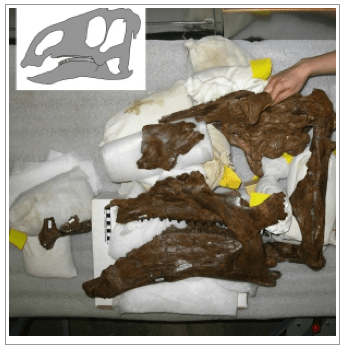MSU paleontologist Jack Horner announces retirement
 photo Kelly Gorham
photo Kelly Gorham
A renowned Montana State University professor who is one of the world’s leading experts in paleontology and who has inspired many to follow him in the field, is retiring.
Jack Horner, Montana University System Regents Professor of Paleontology and Curator of Paleontology at Museum of the Rockies, announced his retirement, effective June 30, 2016.
Horner has brought distinction to MSU and the Museum of the Rockies, and he will be deeply missed, said Shelley McKamey, executive director of the Museum of the Rockies.
“During his 33-year tenure as curator of paleontology at the Museum of the Rockies, Jack and his team of staff and graduate students have amassed the largest collection of dinosaur fossils from the United States,” she said. “He opened the science of paleontology to the general public and sparked the imagination of countless aspiring paleontologists.”
McKamey said a public event celebrating Horner’s career is being planned for early summer, with the date to be announced.
Horner is widely recognized as one of the world’s foremost paleontologists and was a leader in the now-common theory that dinosaurs were warm-blooded social creatures more like birds than cold-blooded animals like lizards. He is also well-known for serving as a scientific consultant to the popular “Jurassic Park” movies directed by Steven Spielberg, and his TED Talk, “Building a Dinosaur from a Chicken,” has been viewed more than 2 million times. He is also the recipient of a MacArthur Fellowship “Genius Grant” award.
In the 1970s, Horner discovered the first dinosaur eggs in the Western Hemisphere, which led to the understanding of dinosaur parenting. He discovered and named the duck-billed herbivore dinosaur Maiasaura, which means “good mother lizard.”
In 2013, Horner was awarded the Romer-Simpson Medal, the highest honor given by the Society of Vertebrate Paleontology, for his lifetime of achievement in vertebrate paleontology. Horner was nominated for the award by longtime collaborator and University of California, Berkley professor Kevin Padian, who wrote, “It is difficult to imagine someone who, rising from such considerable obstacles, has achieved so much, given back so much to the profession, stimulated so much new investigation and supported so many younger colleagues and students.”
Earlier this year, Horner was recognized as one of the world’s top 24 scientists by Newton Graphic Science Magazine along with top researchers in science and medicine, including Nobel Prize-winning physicist Albert Fert.
A national search for Horner’s replacement will be launched in late summer or early fall of 2016, after strategic planning for the museum’s paleontology department that will include opportunity for input from all stakeholders in the museum, university and community, McKamey said.
“It will not be easy to replace Jack,” she said. “The Museum of the Rockies will take the time to do it thoughtfully and deliberately. “


 The paper was written by that professor, Elizabeth Freedman Fowler, and her mentor, MSU paleontologist Jack Horner, Montana University System Regents Professor and curator of paleontology at MSU’s Museum of the Rockies. Their findings highlight how the new species of duckbilled dinosaur neatly fills a gap that had existed between an ancestral form with no crest and a descendant with a larger crest, providing key insight into the evolution of elaborate display structures in these gigantic extinct herbivores.
The paper was written by that professor, Elizabeth Freedman Fowler, and her mentor, MSU paleontologist Jack Horner, Montana University System Regents Professor and curator of paleontology at MSU’s Museum of the Rockies. Their findings highlight how the new species of duckbilled dinosaur neatly fills a gap that had existed between an ancestral form with no crest and a descendant with a larger crest, providing key insight into the evolution of elaborate display structures in these gigantic extinct herbivores.



 Intermountain Opera Bozeman is now accepting entries for its 4th annual poster contest. The contest is presented in conjunction with IOB’s upcoming production of Mozart’s Don Giovanni. The winning artist will receive a $500 grand prize and his or her art may be used to promote the May 2016 production of Don Giovanni. The contest is open to the general public, and all ages and levels of expertise are encouraged to enter.
Intermountain Opera Bozeman is now accepting entries for its 4th annual poster contest. The contest is presented in conjunction with IOB’s upcoming production of Mozart’s Don Giovanni. The winning artist will receive a $500 grand prize and his or her art may be used to promote the May 2016 production of Don Giovanni. The contest is open to the general public, and all ages and levels of expertise are encouraged to enter.



News Comments
Thank you
Open Auditions for Annie
Monday, Sep. 16, 2024
I’m at the Bozeman airport where your painting, “Blowing East” is displayed. It’s absolutely gorgeous! Bravo, Marci!!
The Artists’ Gallery in Bozeman’s Emerson Cultural Center May Exhibits
Sunday, Jun. 30, 2024
This is so typical of a sign in, which we should not have to do to check if we or some one in our party got a permit. I have been working or "creating an account" for 30 minutes and just get the same ...
Smith River permit drawing results available
Sunday, Mar. 10, 2024
I have struggled with this podcast and my own participation therein, the event itself obviously traumatic, but beyond that my inability to reach anyone and convey anything resembling truth. The person ...
Billings, MT Case Becomes True Crime Podcast | 'An Absurd Result'
Marktokarski
Saturday, Jan. 20, 2024